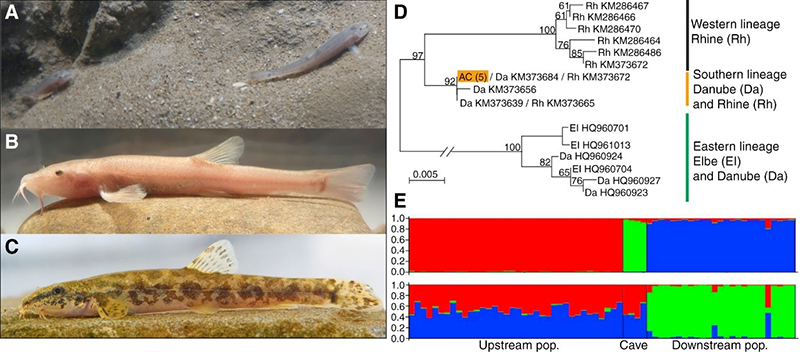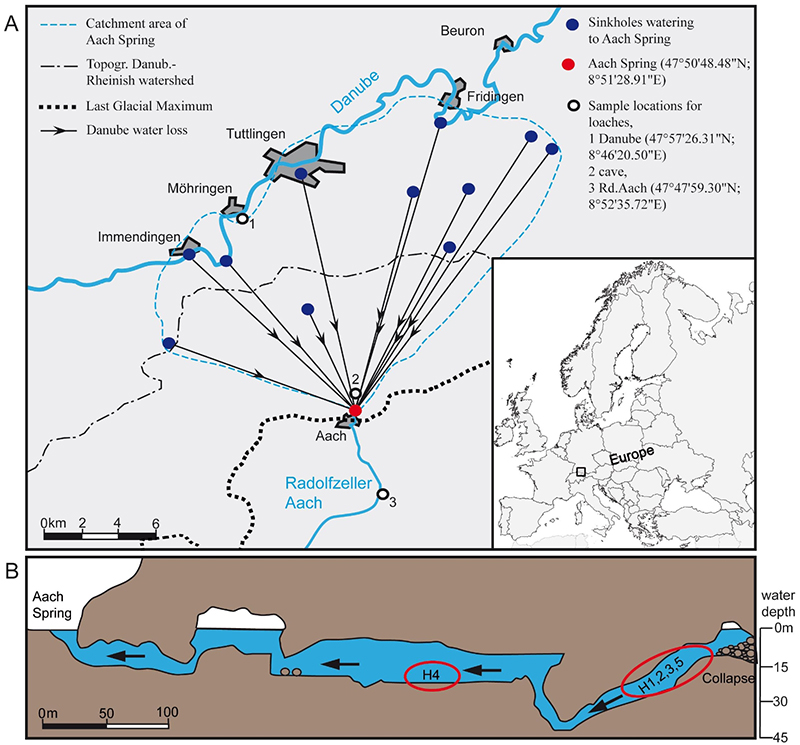Barbatula barbatula (cave form)
[Behrmann-Godel, Nolte, Kreiselmaier, Berka and Freyhof 2017]

| ORDER | SUB-ORDER | FAMILY |
|---|---|---|
| Cypriniformes | Cobitoidei | Nemacheilidae |
Synonyms
None.
Country
GermanyTypes
The specimens used in the first account are deposited in Zoologisches Forschungsmuseum A. Koenig (ZFMK), Bonn (no catalogue numbers).
Distribution
Known only from one locality: The Aach Spring, near Tuttlingen, southern Germany, (47o50’48.48”N, 8o51’28.91”E). This cave carries water from sinks in the Danube River, and elsewhere in the region.
Most subterranean fishes are tropical and subtropical and in the northern hemisphere the great majority are concentrated between 16oN and 25oN with only a handful north of this (Proudlove 2006 Table 3, Figure 1). Among the northerly outliers are populations of Amblyopsis spelaea, Troglichthys rosae and Typhlichthys lineages (Amblyopsidae) in North America, Cottus specus and an undescribed species in the Cottus bairdi-cognatus complex (Cottidae), also in North America and Troglocobitis starostini (Nemacheilidae) in Turkmenistan. At 47oN the German Barbatula is fully 6o further north than a population of Cottus bairdi-congatus complex in xxx. This great stride north, and into significantly glaciated terrain, opens the door to a host of temperate subterranean species so far undiscovered. For this reason alone this is probably the most significant discovery since Amblyopsis spelaea in 1840. [Note that Cobitis damlae (Cobitidae) in Turkey is probably not a subterranean fish].
Habitat
The Aach Spring is the resurgence for the major Danube-Aach hydrological system (Hötzl 1996). It is a major phreatic conduit with no vadose passage and no significant dry passages. It has been explored for a distance of 600m, to a maximum depth of 40m, to where the passage is blocked with breakdown. The nearest sinks are c. 12km distant and the catchment is of c. 250km2. There is clearly a great deal of habitat space within the Danube-Aach System. The nature of the known habitat can be seen in this film. The large catchment, and especially the major inputs from the Danube sinks, will ensure a good food supply for the fishes even though the known population is a the extreme distal end of the system.
Systematics
Genetic analysis using mitochondrial COI markers shows that the cave fishes share markers with surface living Barbatula barbatula from the region and this suggests that the cave fishes are recently evolved. However, population genetic analysis using microsatellite markers shows that the cave fishes are genetically isolated from both upstream and downstream populations of B. barbatula. They also have reduced genetic variability, a feature they share with other cave fish populations (Sbdordoni, Allegrucci and Cesaroni 2000, 2005, 2012, 2019). Genetically isolated populations are species, by both the Evolutionary Species Concept and the Phylogenetic Species Concept, and this animal should be described as a new species. Recent glacial activity in the area suggests that the cave fishes have evolved post-glacially in perhaps as little as 20000 years though this requires further evidence for certainty.
Conservation Status
TLO [NE]
This population is probably completely isolated and may be the only one. It may merit VU D2, at least, if there are any threats.
Museum Holdings
As above only.
Internet Resources
Film of the dive and the fishes
Key References
- Smyly, W.J.P. (1955)
- Bacesu-Mester, L (1967)
- Perrin, J.F. (1980)
- Bless, R. (1985)
- Maitland, P.S. and Campbell, R.N. (1992)
- Hotzl, H (1996)
- Bromidge, N. (2004)
- Fischer, P. (2004)
- Kottelat, M. and Freyhof, J. (2007)
- Coghlan, A. (2017)
- Behrmann-Godel, J., Nolte, A.W., Kreiselmaier, J., Berka, R. and Freyhof, J. (2017)
- Behrmann-Godel, J. and Nolte, A.W. (2018)
- Freyhof, J. (2022)
- Behrmann-Godel, J., Roch, S., Böhm, A., Jolles, J. and Brinker, A. (2023)
- Jolles, J.W., Böhm, A., Brinker, A. and Behrmann-Godel, J. (2024)
- Behrmann-Godel, J., Roch, S., Böhm, A., Jolles, J.W. and Brinker, A. (2024)
- Kleinschmidt, Y., Ros, A., Behrmann-Godel, J. and Brinker, A. (2024)
- Parrott, F. (2025)
| Smyly, W.J.P. | Journal Article | 1955 | On the biology of the Stone Loach Nemacheilus barbatula (L.) |
| Bacesu-Mester, L | Journal Article | 1967 | Contributions to the study of the genus Noemacheilus (Pisces, Cobitidae) |
| Perrin, J.F. | Journal Article | 1980 | Structure et functionement des ecosystemes du Haut-Rhone francaise. 14. etude des preferences alimentaire de la loche franche (Noemacheilus barbatulus L.) par une methode des points modifee |
| Bless, R. | Journal Article | 1985 | Zur regeneration von Blachen der Agarlandschaft - Eine ichthyologische Fallstudie |
| Maitland, P.S. and Campbell, R.N. | Book | 1992 | Freshwater fishes of the British Isles |
| Hotzl, H | Journal Article | 1996 | Origin of the Danube-Aach system |
| Bromidge, N. | Book Section | 2004 | Stone loach Barbatula barbatula |
| Fischer, P. | Journal Article | 2004 | Nocturnal foraging in the stone loach (Barbatula barbatula): Fixed or environmentally mediated behavior? |
| Kottelat, M. and Freyhof, J. | Book | 2007 | Handbook of European freshwater fishes |
| Coghlan, A. | Web Page | 2017 | First ever cave fish discovered in Europe evolved super-fast |
| Behrmann-Godel, J., Nolte, A.W., Kreiselmaier, J., Berka, R. and Freyhof, J. | Journal Article | 2017 | The first European cave fish |
| Behrmann-Godel, J. and Nolte, A.W. | Journal Article | 2018 | Evolutiv junge europäische Höhlenfische |
| Freyhof, J. | Web Page | 2022 | Barbatula barbatula (Errata version 2019) |
| Behrmann-Godel, J., Roch, S., Böhm, A., Jolles, J. and Brinker, A. | Journal Article | 2023 | Phenotypic plasticity and genetic differentiation drive troglomorphic character development in European cave loach |
| Jolles, J.W., Böhm, A., Brinker, A. and Behrmann-Godel, J. | Journal Article | 2024 | Unravelling the origins of boldness behaviour: a common garden experiment with cavefish (Barbatula barbatula) |
| Behrmann-Godel, J., Roch, S., Böhm, A., Jolles, J.W. and Brinker, A. | Journal Article | 2024 | Genetic differentiation and phenotypic plasticity drive troglomorphic character development in European cavefish |
| Kleinschmidt, Y., Ros, A., Behrmann-Godel, J. and Brinker, A. | Journal Article | 2024 | Navigation in the dark: early behavioural adaptation of Europe's only native cave fish |
| Parrott, F. | Journal Article | 2025 | Invisible fish |

